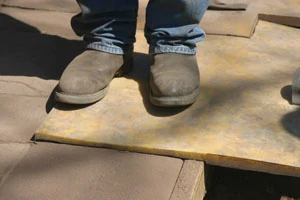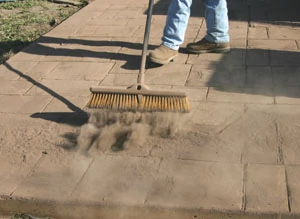By Monte Burch
Build a Patio with Decorative Concrete.
Concrete is one of mankind’s most useful inventions, and also one of the oldest. Highways, sidewalks, bridges, buildings, all are made of this utilitarian and often unglamorous product. Concrete, however, doesn’t have to be mundane. With a variety of techniques concrete can be made extremely decorative. Stained and stamped with a variety of patterns, concrete can look like bricks, cobblestone, flagstone, even wood, or a variety of unusual artistic patterns. Stained and stamped concrete can turn a ho-hum slab into a beautiful patio or sidewalk. It is also a great way of redoing an old, deteriorated walk or patio—simply pour fresh concrete over the old.

Prep the Site
The first step, as in any concrete project, is proper preparation of the site and building a form to hold the concrete in the desired shape. The sub-grade must be uniformly graded and evenly compacted. If pouring in hot weather, it is recommended to soak the ground prior to the pour. The sub-base material, however, must be dry at the time of the pour.

If pouring a patio or walk, the mix and reinforcing should meet the strengths of the project needs and be suitable for external paving. The formwork should be set to establish proper drainage of the area and to be used for screeding and layout. A minimum of 2-percent slope should be allowed for exterior paving sections. All grade pins should be set below grade to prevent interfering with the texturing process. All formwork should be properly squared, and also squared to any existing structures. This is especially important if using a patterned texturing tool.

Colorful Concrete
Two methods are used for coloring concrete, a spread-on color hardener or an integral colorant. Both can be used with ready-mixed or bagged materials. Color hardener has some dust and health hazards in application due to the content of the silica sand involved. The technique shown involves integral coloring products from Matcrete (www.Matcrete.com).

The Matcrete Integral Color is a pre-measured admixture for coloring ready-mixed concrete during batching. The pigments are lime-proof, pure synthetic mineral oxides for all concrete flat-work installations, interior floors and exterior hardscapes. The system also works for precast, tilt-up and cast-in-place applications. Packaged in 25-pound disintegrating bags, the product is available in a wide range of colors. The dosage rate found with the color swatch is the amount of color needed to tint 94 pounds of concrete. Typical dosage rates range from 1/4 to 4 pounds of Matcrete Integral Color per sack (94 pounds of cement). Exceeding 10-percent color content can have an adverse affect on the strength of the concrete. If a more vibrant color is desired, consider using Matcrete Dustone Color Hardener which, due to its application, is not limited to these same restrictions and in fact can increase surface strength. But you must follow all safety regulations.

Integral Color is added to the concrete in the mixing drum. If mixed at the plant, the drum must be cleaned, and approximately two-thirds of the mix water and one-half of the aggregates needed should be added to the drum. Do not use slurry water or reclaimed aggregates. Add the correct amount of Matcrete Integral Color to the drum and mix at full charging speed for three to five minutes or until all bags break apart and the pigment is distributed evenly. Add the balance of the ingredients (water, aggregates, cement and admixtures) and mix at full charging speed for 8 to 10 minutes (80 to 100 revolutions). It is the ready-mix supplier’s responsibility to make sure the bags have fully disintegrated. Note: A ready-mix company will probably charge a small fee for extra cleaning of the drum.

If coloring the concrete at the jobsite, open the bag and pour the pigment directly into the drum, then discard the bag. Again mix thoroughly before distribution. Mix color and pre-bagged concrete according to the manufacturer’s specific instructions.

Texture Options
The colored concrete can be finished in a variety of means. Use a bull float after striking off the slab. For most finishes, use wood bull floats and derbies, not magnesium. Wait for the bleed water sheen to disappear before you start floating and troweling. Do not over-trowel or start troweling late as this leads to burns and dark spots.


Following are some of the various textures that can be used with Matcrete Integral Color:
Broomed: Made by pulling special brooms across stiff, freshly floated or troweled concrete surface. For variety, broomed texture can be heavy or light, or in straight or wavy lines.
Exposed Aggregate: Aggregate is exposed by “seeding” the fresh concrete with aggregate, which can be colored, sparkling, fractured or smooth. Before the concrete sets thoroughly, a pressure washer is used to wash away some of the top surface and expose the aggregate. Set-retarding compounds are often used to slow the set, but make sure you follow the manufacturer’s instructions. The aggregate can also be exposed by removing the surface cement with acid etching, sand blasting, grinding or hammering. Exposure level can vary from barely revealing fine aggregate to up to 1/3 of the diameter of coarse aggregate exposed.
Stamping or Imprinting: Stamping tools are pressed into the concrete to create a pattern and then removed. A powder release agent or plastic sheet is placed on the concrete surface after floating and troweling.

Stamping in Detail
A wide variety of stamps are available ranging in design from brick, cobblestone, stone, and ashlar slate to patterns that resemble wooden planks. Matcrete has over 175 patterns to choose from. The concrete stamps are made from a high-quality urethane with fixed handles designed for quick and easy placement. Stamps are available as seamless imprinting or in set patterns. Seamless texture or non-directional patterns are the easiest and fastest way of stamping concrete as there is no set direction or lay-down pattern to follow. Regardless, a wide set of variables is involved in properly imprinting concrete including: temperature, sunlight or shade, wind, access and the depth of the stamping tool.


Regardless of the design used, the concrete should be covered with either a plastic membrane or release powder to prevent the cement from sticking to the concrete stamp. Matcrete Release Powder, a fine talc-like powder, is not only quick and easy to use; it adds a secondary color to the Color Hardened concrete. Before application of the release powder, it should be air-entrained to beat air back into it. The fine powder settles during transportation. A portable electric drill and paddle mixer works quite well. Broadcast the powder over the surface by hand, brush or even the lid from the bucket. Broadcast as low to the surface as possible, tossing the powder across and not down on the surface. Avoid lumps on the surface, as this may create blank spots in the texture. The rate of application depends on the concrete set rate, depth of desired texture and wind speed. Do not apply this on a windy day. Approximately 3-1/2 pounds is required per 100 feet.


Patterned Stamping
Patterned stamping requires careful layout and tool placement. Joint spacing must be considered. You will need stamping tools to span the entire slab in one direction and begin the second row. It’s a good idea to lay out the design and even lay out the stamping tools in the pattern desired next to the pour, so you’re sure of the tool positioning. Once you have determined the pattern, and that the concrete will hold up to the weight of the person and tool, you’re ready to place the first stamp.


Place the stamp flat on the surface of the concrete using the handles on the back. If possible, start against the structure or any straight edge that will permit the tool to remain square. Do not drag the stamp across the concrete as this will scuff and scratch the surface and mar the imprint. Continue to set the remaining stamping tools, following the instructions for that particular pattern. Patterned tools are color-coded to help reduce pattern repeat on the surface. Rotate the colors so the surface is randomly stamped.


Once all the tools are in place, use a pounder or tamping tool to create the imprint. If the concrete is too soft to continue stamping you should refrain from stamping until it has the same consistency and will properly support the weight of the person and tool. Continue to move and tamp the tools in the direction of the pour until the entire surface has been imprinted. Always set the next row tight to the first to keep the lines square. Using a small Seamless Texture Skin, work around hard-to-reach edges such as steps, walls and columns. Additional detailing can be done using a touch wheel and chisels.


Seamless Texturing
You will need a minimum of three large Seamless Texture Skins. Place the first flat on the surface using the handles. Then place the second and third, overlapping each by 4 to 6 inches. Once you have stamped the texture evenly into the concrete you must underlap the first skin from the other two before you can pick it up and move into the next position. Repeat the process until you have covered the complete area. When you move each stamp, rotate it 90 degrees to ensure there is no repeat of the design.

Curing and Cleanup
The next steps are curing and wash-down. The main purpose of curing is to increase durability and reduce early carbonation on the surface. Keeping the powdered release agent on the surface for a period of seven days will help prevent early carbonation by limiting the exposure to carbon dioxide in the atmosphere. Regardless, it is recommended the concrete has a minimum of 48 hours to harden before the wash-down procedure.
The first step is to remove all forms, then sweep excess release powder from the surface. Collect as much of the release powder as possible in a ditch or sump hole. Then dampen the concrete surface with water. Using a pressure washer with a minimum of 2,000 psi, clean off the release powder. Working the dampened surface with a soft-bristle push broom will also help. Matcrete Antique Release and Efflorescence remover can also be used to remove stubborn stains. Clean the concrete surface until the water runs clear and the overall appearance is desired.
The final step is to apply a sealer to protect the concrete and seal in the coloring. A number of sealers are available, and it’s extremely important to follow the directions for the specific sealer. The concrete should be sufficiently cured and moisture migration complete. The surface must be free of dust, debris, moisture and any other contaminants. The first coat of sealer should be applied evenly with a high-pressure sprayer. The second coat can be applied when the first coat has thoroughly dried (three hour re-coat time). Depending on the porosity of the concrete, you may need a third coat. Foot traffic is permitted within 24 hours and vehicular within 72 hours.



